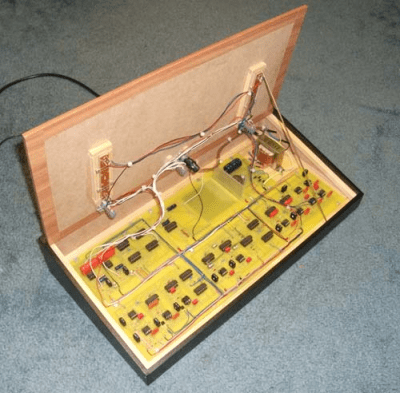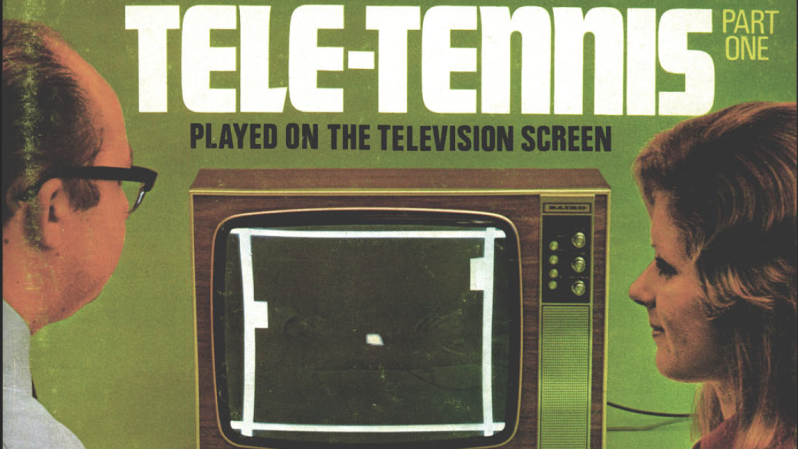
Back in November 1974 the publication “Practical Wireless” produced a five-part article series showing the reader how to construct a version of the popular “pong” game that could be played on the television screen available in the typical British home. [Grant Searle] had wanted to build this project for years, but it took him until 2008 to find the opportunity to do so. The magazine article printed PCB layouts to 1:1 scale, with a bill of materials and assembly instructions. After each month, the reader would have an assembled the project a little more, with the final month dedicated to point-to-point wiring and final setup. Subsequent months contained some enhancements such as a scoring system and sound effects, but these are not yet part of the main build. In order to understand the build, you will need to download the PDF copy of the magazines prints. (And if you’re an electronics nerd like this scribe, you’ve already done that right?)

The electronics are based upon pure discrete 7400-series logic, 741 opamp-based ramp generators and, you guessed it, 555 timers. The way the various boards have discrete functions is particularly interesting. For example, in part 3, the PCB described (board A) not only is the master field/line sync generator, but also generates the video signals for the ball, with its position and size determined in an analogue fashion. Signals coming into the board from Board C (top/bottom base) cause a discrete flip-flop to toggle, changing the ball’s direction as it ‘bounces’ off the edge of the screen. Each board generates its own video signal, which are then all combined in the final video mixer (board E) that simply wire-OR’s them all with the composite sync to generate the composite video needed. This would have been tapped off and fed to a UHF video modulator, but [Grant] chose not to install that for the build. The whole thing was wrapped up inside an MDF case, coated in that dubious fake-wood plastic wrap, for that very 70’s aesthetic some of us remember fondly.
Pong is such a popular classic game, that we’ve covered many, many variants over the years. Here’s one that’s purely mechanical, another that uses the original PCB with a visually appealing twist, and finally, a completely virtual simulation of the original arcade circuit, courtesy of Falstad. We’re sure there will be many more to come.
Thanks [JohnU] for the tip!















In the US, a project wouldn’t have lasted five months. Either it would be crammed into one or two issues, or there’d be more an introductory article and yiu coukd send a dollar or so for plans. Or buy. the kit.
But in 1976, I think it was, Popular Electronics had a CMOS Space Wars, in one article. I think the same issue had sone other game too.
Pre 1980 was definitely more of a golden or maybe silver age for magazine projects, before they devolved to “here’s a sketch 2 photos and a brief writeup, BUY THE PLANS AND PCB (and maybe an eeprom, preprogrammed PIC or other code that we said was “free” to download at a BBS that was always busy for a few short years until we turned it off.) At the start of the 70s, everything would be in the mag, but as we got to 1980+ it degraded into twisting your arm to buy stuff… by 1990 the magazines were thick with ads, but mostly the articles were also infomercials. More on the purely golden side was maybe 1930 to 1970. Still some good stuff pre 1930, but unless it was a “for Boys” type publication the writeups were a bit terse and assumed total familiarity with shop procedures of the day.
Could maybe even call it platinum or palladium era through the Fifties, they’d tell you how to make anything, life and limb be damned :-D I exagerate, they merely had the presumption of common sense on the part of the reader.
Though, the Mark 8 in 1974 neededtheplans as did the Altair a few months later. It was starting to shift.
I recall some comment at the time that one reason Popular Electronics went to the larger format in the fall of 1974 was to handle bigger projects.
It did get worse later, more and more obscure devices that were very integrated.
It was the April 1976 issue of Popular Electronics. A game of pong, “Pongtronics” and a game of Space Wars, back to back. The latter written by Joseph Weisbecker, of RCA 1802, Cosmac Elf, and the CHIP-8 programming language fame. If he’d waited till that summer, maybe Space Wars coukd be programned on the Cosmac Elf.
A friend breadboarded Space Wars at the time, we never got it to work. I have no idea if there were errors in the schematic, or wiring errors.
Folks, if you are going to post something from Grant Searle, at least show his main page:
http://searle.x10host.com/index.html
Grant is a legend in the retro computing scene, his 6502, The simple Z80, his CP/M machine, software for these are all well known and many many copies were built over the years.
That old 1500 could do with a little bit of a pin-cushion tweak don’t you think, Jenny?
The problem with most electronic magazines is they put deliberate errors in their projects to make you buy every magazine this became tedious and caused people to stop buying the mags pw were the worst for errors elektor used to be good with few mistakes at least the projects were interesting now elektor and pe are too complicated maplin were good for projects until they gave up the hobby market if you build old projects look for all the many deliberate errors
Trying to get back on topic: perhaps the most significant thing about this project is that it showed how using 555s (/lots/ of 555s) each doing a comparatively simple job could synergistically result in a complex result.
I have difficulty imagining anybody driving DVI/HDMI using such meager resources: and the community is the poorer for that.